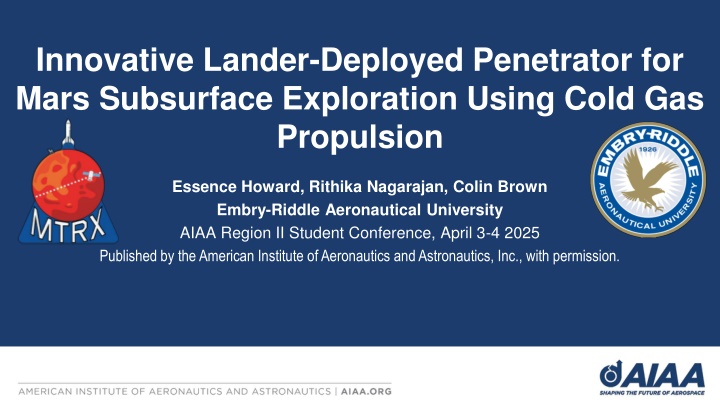
Innovative Lander-Deployed Penetrator for Mars Subsurface Exploration
Explore the innovative propulsion technology for Mars subsurface exploration presented by a team from Embry-Riddle Aeronautical University. Learn about the challenges, objectives, constraints, and design innovations involved in this groundbreaking project aimed at enhancing our understanding of Mars' geological history and potential resources.
Download Presentation

Please find below an Image/Link to download the presentation.
The content on the website is provided AS IS for your information and personal use only. It may not be sold, licensed, or shared on other websites without obtaining consent from the author. If you encounter any issues during the download, it is possible that the publisher has removed the file from their server.
You are allowed to download the files provided on this website for personal or commercial use, subject to the condition that they are used lawfully. All files are the property of their respective owners.
The content on the website is provided AS IS for your information and personal use only. It may not be sold, licensed, or shared on other websites without obtaining consent from the author.
E N D
Presentation Transcript
Innovative Lander-Deployed Penetrator for Mars Subsurface Exploration Using Cold Gas Presentation Title Propulsion Essence Howard, Rithika Nagarajan, Colin Brown Embry-Riddle Aeronautical University AIAA Region II Student Conference, April 3-4 2025 Published by the American Institute of Aeronautics and Astronautics, Inc., with permission. Author Company/Organization Conference Name, Conference Dates Conference Location
Background Mars' subsurface exploration is crucial for understanding geological history and identifying resources for future missions. Challenges include regolith composition, extreme environmental conditions, and achieving sufficient depth while maintaining instrument integrity. Previous attempts to deploy penetrators on Mars have faced failures, including NASA's Deep Space 2 mission in 1999. 2
Previous Attempts Previous attempts to deploy penetrators on Mars have faced failures, including NASA's Deep Space 2 mission in 1999 and Russia s Mars 96 mission in 1996. This is an image of NASA s penetrator from the Deep Space 2 mission. 3
Objectives Addresses limited surface exploration data due to cosmic radiation, oxidation, and weathering. Deep Subsurface Probes enhances the likelihood of detecting preserved biosignatures or signs of past life. Develops controlled penetrator system using cold gas thrusters for enhanced structural integrity. Enables autonomous operation and long-duration data collection. 4
Constraints Endure temperature variations from -125 C to 20 C and operate under low atmospheric pressure (~6 mbar) with resistance to extreme dust conditions. Utilize a stable lander platform for penetrator deployment with cold gas thrusters providing controlled penetration to a depth of 1.75 meters. Incorporate rugged, miniaturized scientific instruments including seismometers, spectrometers, temperature and pressure sensors, microscopic imagers, and moisture detection sensors. 5
Design Innovations Cold gas thrusters provide precise depth modulation, adapting to various terrain types. Tungsten-tipped nose cone ensures efficient penetration through dense layers. Aluminum foam-filled (AFFT) shock absorbers protect onboard systems, preventing excessive force transmission. Hybrid power system combines high-energy-density lithium- ion batteries with radioisotope thermoelectric generators for a robust energy supply. 6
System Design This figure depicts the interconnected parts of the Mars lander mission, tracing the path from mission control to scientific payload operations. 8
Power and Communication Systems Store data locally in non-volatile memory in case of transmission delays. Utilize waste heat from electronics or RTG to prevent freezing of critical components. Use MEMS-based (Micro-Electro-Mechanical Systems) sensors for compact, low-power instrumentation. 9
Subsystem Designs Utilizes radiation-hardened electronics covered with depleted boron for protection against high-energy particle destruction. Utilizes UltraFlex Solar Arrays for efficient power management during planetary exploration. Equipped with a VibraTech seismometer for seismic activity detection and environmental monitoring sensors like BME280 for temperature, humidity, barometric pressure, and volatile organic compounds. 10
Testing and Simulations Temperature cycling ensures functionality of materials, electronics, and power systems. Penetrator tested in low-pressure environment for thruster efficiency. Cold gas thruster stability test to assess propulsion system's control over trajectory and penetration depth. Field tests in Martian analog environments to validate penetration ability, sensor performance, and communication systems. 11
Conclusion Employs a thruster-assisted deployment to mitigate risks of communication loss, structural failure, and inadequate penetration depth. Features a high-strength, structurally reinforced penetrator casing to withstand extreme environmental conditions. The system's modular design allows for future modifications based on mission-specific requirements. 12
